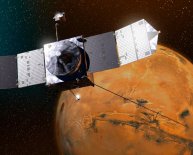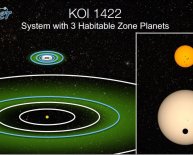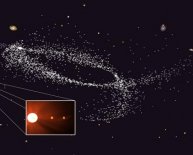
Heliocentric Motion
 Geocentric view: Earth-centered view. (600BC – 150 AD)
Geocentric view: Earth-centered view. (600BC – 150 AD)
Came from the belief that God created humans at center and everything moved in perfect divine circles.
- Earth was a sphere that remained motionless at center of the universe
- Sun, Moon, Mercury, Venus, Mars, Jupiter and Saturn orbited earth in circles
- Stars traveled around the earth on a celestial sphere (transparent and hollow sphere)
- Earth was spherical because it casts a curved shadow when it eclipses the moon
Early Greeks rejected this idea of the Earth rotating because it seemed too large to be movable and there was no sense of motion
Problem: The planets would experience retrograde motion. This is a westward motion of planets. (The earth has a faster orbital speed, so planets look like they are moving backwards)
Scientist Almagest (141 AD):
- Planets orbit on small circles called epicycles. These revolve round large circles called deferents.
- The Roman Catholic Church accepted his model as the correct one
Heliocentric view: Sun-centered view. (1473-1543)
- Daily motions of heavens could be better explained by rotating and revolving earth
- Earth is a planet
- Model consisted with the sun at center, with Mercury, Venus, Earth, Mars, Jupiter and Saturn orbiting.
- Retained circular orbits with epicycles to match observations
Scientist: Brahe
- Made observations without a telescope, however, they were far more precise than any made previously
- Did not believe in the Heliocentric view because he could not observe the stellar parallax.
o Stellar Parallax: If the earth does not revolve around the sun, the position of a near by star, when observed from extreme points in earths orbit, should shift with respect to more distance stars. The stellar parallax could not be measured because the distance to nearby stars is too far to measure with a primitive telescope let alone the naked eye.
Kepler’s Law
- Used Tycho’s observations to support Copernican view.
- Could not fit observations of Mars to circular orbit,
and did not want to abandon observations. - Mars has elliptical orbit.
- Mars speeds up as it approaches sun, slows down as it moves away.
1) Path of each planet is ellipse, with Sun at one focus.
Ellipse – The sum of the distances from two points (foci) to every point on the curve is constant.
2) Each planet revolves so that imaginary line connecting it to the Sun sweeps out equal areas in equal times therefore; planet travels faster when closer to the sun.
Problem: Could not explain what forces are acting to produce planetary motion.
Scientist: Galilei
- Supported Copernican view
- Made telescope with magnification of 30
(Not inventor of telescope) - Discoveries included:
a) Moons of Jupiter
b) Moon has craters, not smooth glassy surface
c) Sunspots (dark patches on Sun); Sun is blemished
d) Sunspots move – Sun rotates
Scientist: Newton
- Needed to explain what force kept planets from moving in straight line.
- Law of universal gravitation:
Every body in the universe attracts every other body with a force that is directly proportional to their masses and inversely proportional to the square of the distance between them.
- Newton proved that gravity and inertia together work to keep planets in their elliptical orbits.
Citation
St. Rosemary Educational Institution. "Models of celestial motion: Geocentric & Heliocentric." St. Rosemary Educational Institution, Last Update: 2016. Web. Retrieved on: Friday 30th September 2016.

















